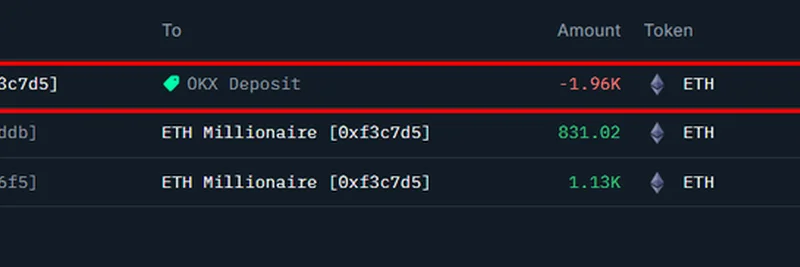In the fast-paced world of cryptocurrency, big players—often called "whales"—can make waves with their moves. Recently, Onchain Lens, a platform dedicated to simplifying blockchain data, spotlighted an intriguing transaction on X (formerly Twitter). An Ethereum whale deposited 1,962 ETH, valued at around $9.38 million, into the OKX exchange. This comes after the holder kept their ETH stash untouched for more than 11 months, ultimately pocketing a tidy profit of $4.7 million.
Decoding the Onchain Activity
Let's break this down simply. The address in question—0xf3c7D5b83DCf6F297E4B1f5A525C1a3eE45D5585—is labeled as an "ETH Millionaire" in onchain tracking tools. According to the data shared in the original tweet, this whale received significant ETH inflows from Binance over 300 days ago, building up their position.
Fast forward to now: The whale sent 1,962 ETH to an OKX deposit address. At current prices, that's a hefty sum, but the real story is in the gains. By holding through market ups and downs, they turned their initial investment into a $4.7 million profit. This kind of long-term holding, or "HODLing" in crypto slang, is a strategy many aspire to, but whales like this one execute it on a grand scale.
For those new to the space, onchain analysis involves examining blockchain transactions directly. Tools like those from Onchain Lens pull data from explorers such as Etherscan, making it easier to spot patterns without diving into raw code.
Why Deposit to an Exchange Like OKX?
Depositing to a centralized exchange (CEX) like OKX often signals intent to sell or trade. Whales might be taking profits, diversifying into other assets, or even preparing for a market shift. OKX, one of the top crypto exchanges, offers high liquidity, making it ideal for large trades without causing too much price slippage—that's when a big order moves the market price against you.
In the broader context, ETH serves as the backbone for many decentralized applications, including popular meme tokens on the Ethereum network. Movements like this can influence ETH's price volatility, which in turn affects meme coin markets. If ETH dips due to selling pressure from whales, it could create buying opportunities or shake out weaker hands in meme projects built on Ethereum.
Implications for Meme Token Traders and Blockchain Enthusiasts
At Meme Insider, we keep an eye on these whale activities because they often ripple through to the meme ecosystem. While this transaction is pure ETH, savvy traders watch for whales reallocating capital. Could this profit be funneled into emerging meme tokens? Or is it a sign of caution amid market uncertainty? Ethereum's role in hosting meme coin launches via platforms like Pump.fun or direct smart contracts means ETH liquidity directly impacts meme hype cycles.
If you're building in blockchain or trading memes, tools like Onchain Lens are invaluable for staying ahead. They democratize data that was once only accessible to pros, helping you spot trends early.
This event underscores the importance of patience in crypto investing. Holding through volatility paid off big here, but remember, past performance isn't a guarantee—always do your own research (DYOR) before making moves.
Stay tuned to Meme Insider for more breakdowns on onchain events, meme token launches, and crypto knowledge to level up your game.


